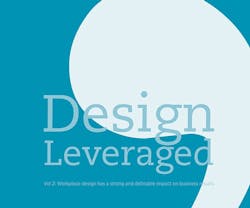Over the course of a lifetime, most of us will spend an average of 90,000 hours working, according to “Happiness at Work” author Jessica Pryce-Jones, which means where we work matters—a lot. Whether you’re conducting business from an office with four walls and a door, a co-working space, the comfort of your own living room, or one of the ubiquitous open-plan offices popularized by tech culture, your workplace environment is affecting everything from your productivity to your desire to collaborate with your coworkers to how much you like your job.
As designers, this is something we have understood intuitively for decades, but often we struggle to articulate the value of design with hard data and statistics. Now, a new study conducted by Brandware Research, and commissioned by the International Interior Design Association (IIDA) and the Business and Institutional Furniture Manufacturers Association (BIFMA), provides commercial interior designers with the numbers they need to showcase the difference design makes when it comes to employee satisfaction. Design Leveraged, Volume II, the second in a three-part series from IIDA and BIFMA, takes a deep dive into this research and makes the case that not only does good design make a meaningful impact on employee satisfaction, but good design is good for the bottom line, as well.
“The results of the Brandware research make clear that beyond wages, benefits, vacations, and promotions, workplace design is strongly linked with employee retention, engagement, and productivity,” said IIDA executive vice president and CEO Cheryl S. Durst, Hon. FIIDA, LEED AP. “Clients want to understand the return on their workplace design investment, and in Design Leveraged we are providing the thought-provoking, statistically significant data and key case studies that will resonate with C-level executives, making this report a vital tool for firms that need to communicate the value of an office redesign.”
Just how much of a difference does design make? More than 1,200 office workers participated in Brandware’s survey, which measured their level of satisfaction with their workplace design as well as other aspects of employee satisfaction and engagement. The results showcase the stark differences between employees who are satisfied with their workplaces versus those who are not. According to the report, “At highly statistically significant levels, Brandware found that employees who are more satisfied with their personal workplace are less likely to quit, are more engaged at work, have higher job satisfaction, make better coworkers, and show more support for corporate goals.”
The data also reveals that nearly half of sampled workers are not satisfied with their workplace environments. Design Leveraged takes a closer look at these two groups and the implications companies face when they disregard the importance of good design.
Here’s a glimpse at the disparities:
Employee retention. Brandware asked survey respondents if they agree with the following: “If I have my way, I will be working here a year from now.” Nearly half—47%—of the group that is highly satisfied with their workplace strongly agreed. Of the less-satisfied group, only 17% strongly agreed.
Workplace satisfaction. “In general, I like working here.” Only 33% of the less-satisfied group agreed with this statement, while an astounding 80% of the highly satisfied group agreed.
A culture of productivity. “My organization cares about my opinions.” More than 60% of highly workplace-satisfied subjects agreed. By comparison, only 20% of those who were less satisfied with their workplace agreed.
Innovation. “My organization is innovative.” Of those highly satisfied, 61% agreed compared to only 21% of the less-satisfied group.
Teamwork. The survey asked, “How often do you willingly give your time to others who have work-related problems?” The group that is highly satisfied said “always” 29% of the time; the less-satisfied group said “always” 13% of the time.
Designed Leveraged features eight case studies illustrating the impact of these findings—from corporate giants such as IBM and AMC Entertainment to start-ups like Harry’s and Wistia to a growing community college and one of the most respected names in healthcare, Mayo Clinic. These companies have harnessed the power of design to recruit and retain the best of the best in a competitive talent market and are sharing the best practices and lessons they’ve learned along the way. In addition, a case study featuring the Well Living Lab, a collaboration between Delos and Mayo Clinic, offers a look at the future of evidence-based design.
To demonstrate how firms and clients can put this data to use, Design Leveraged includes practical advice from IIDA and BIFMA for prioritizing budget dollars in an office redesign—from the simplest, most cost-effective changes a company can make to the most vexing employee complaints about workplaces that can be solved with smart design. Designers, this is your opportunity to make the business case that “companies that take design seriously will reap the benefits of a happier and productive workforce with lower costs of turnover.” Find the survey results, analysis, and more in Design Leveraged, Volume II.
Complimentary digital copies of Design Leveraged, Volume II, are available to IIDA members and for purchase by non-members. Printed copies are also available. For more information, visit www.iida.org.
